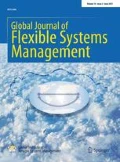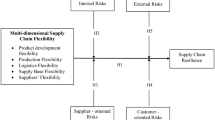Abstract
Supply chain flexibility (SCF) is being viewed most important among the tools to counter and handle risks and uncertainties in today’s volatile markets. It may also be considered to plan strategies, in order to gain competitive edge over competitors. Recently extensive work is being reported in SCF focussing mainly on its multi dimensional aspects and implementation. However SCF is no free lunch and it may require huge investments to realise its potential benefits. ‘How much flexibility is required’, thus becomes the prime concern for firms willing to be flexible. This question is rarely discussed in the literature and in its scarcity, flexibility performance measurements remains untouched for risky and uncertain environments. Therefore measuring SCF is a prominent field where research needs to be focused. In this paper a mathematical model is proposed to evaluate supply chain flexibility at supplier buyer interface with an aim to attain robust supply in all possible scenarios. Further cost of procurement in view of flexibility is investigated in disastrous scenarios to support procurement decisions by managers. The paper contributes by analysing and evaluating SCF in environment of demand and lead time uncertainties and risks of major plant disruptions.






Similar content being viewed by others
References
Adrian, E. (2007). Evaluating operations flexibility in industrial supply chains to support build-to-order initiatives. Business Process Management Journal, 13(4), 572–587.
Barad, M., & Sapir, D. E. (2003). Flexibility in logistic systems-modelling and performance evaluation. International Journal of Production Economics, 85(2), 155–170.
Baum, J. (1999). Back on track, Far Eastern Economic Review, Hong Kong, November 25.
Blome, C., et al. (2013). The impact of knowledge transfer and complexity on supply chain flexibility: Aknowledge-based view. International Journal of Production Economics,. doi:10.1016/j.ijpe.2013.02.028i.
Daniel, A. A., Oscar, F. B., & Vanesa, B. M. (2011). Operations flexibility and outsourcing benefits: An empirical study in service firms. The Service Industries Journal, 31(11), 1849–1870.
Das, S. K., & Abdel-Malek, L. (2003). Modelling the flexibility of order quantities and lead-times in supply chain. International Journal of Production Economics, 85(2), 171–181.
Das, S. K., Kanchanapiboon, A., & Kesen, S. E. (2010). Evaluating supply chain flexibility with order quantity constraints and lost sales. International Journal of Production Economics, 126(2), 181–188.
Garavelli, A. C. (2003). Flexibility configurations for the supply chain management. International Journal of Production Economics, 85, 141–153.
Gosling, J., Naim, M., & Towill, D. (2012). A supply chain flexibility framework for engineer-to-order systems. Production Planning & Control,. doi:10.1080/09537287.2012.659843.
Graves, S. C., & Tomlin, B. T. (2003). Process flexibility in supply chains. Management Science, 49(7), 907–919.
Gunasekaran, A., Patel, C., & Tirtiroglu, E. (2001). Performance measure and metrics in a supply chain environment. International Journal of Operations and Production Management, 21(1–2), 71–87.
Gunasekaran, A., Patel, C., & McGaughey, R. E. (2004). A framework for supply chain performance measurement: supply chain management for the 21st century organizational competitiveness. International Journal of Production Economics, 87(3), 333–347.
Herwig Winkler, (2009). How to improve supply chain flexibility using strategic supply chain networks. Logistics Research, 1, 15–25.
Hong, P., Huang, C., & Li, B. (2012). Crisis management for SMEs: insights from a multiple–case study. International Journal of Business Excellence, 5(5), 535–553.
Jack, E. P., & Raturi, A. (2002). Sources of volume flexibility and their impact on performance. Journal of Operations Management, 20(5), 519–548.
Ji, G., & Zhu, C. (2008). Study on supply chain disruption risk management strategies and model. International Conference on Service Systems and Service Management, July 2008, Melbourne, VIC.
Johnzén, C., Pérès, S. D., & Vialletelle, P. (2011). ’Flexibility measures for qualification management in wafer fabs. Production Planning & Control, 22(1), 81–90.
KamelAisaFantazy, (2009). An empirical study of the relationships among strategy, flexibility, and performance in the supply chain context. Supply Chain Management, 14(3), 177–188.
Kleiderman, A. (2004). Soggy summer spells boardroom gloom. BBC News (September 24), http://news.bbc.co.uk/1/hi/business/3686742.stm.
Koste, L. L., Malhotra, M. K., & Sharma, S. (2004). Measuring dimensions of manufacturing flexibility. Journal of Operations Management, 22(2), 171–196.
Latour, A. (2001). Trial by fire: A blaze in Albuquerque sets off major crisis for cell-phone giants. The Wall Street Journal. Eastern Edition, January 29.
More, D., & Subash, Babu A. (2012). Investigation of supply chain flexibility using a forced field analysis – a case study. International Journal of Services and Operations Management, 11(4), 449–480.
More, D. S., & Subash Babu, A. (2007). ‘Identification of stimuli, enablers and inhibitors of supply chain flexibility and an analysis of their dynamics’, Proceeding of the National Conference on Business Optimization Research Wave-2007. Mumbai: NITIE.
More, D., & Subash Babu, A. (2011). Managing Supply Chain Flexibility using an integrated approach of classifying, structuring and impact assessment. International Journal of Services and Operations Management, 8(1), 46–75.
Nair, A. (2005). Linking manufacturing postponement, centralized distribution and value chain flexibility with performance. International Journal of Production Research, 43(3), 447–463.
Nanto, D. K., Cooper, W. H., Donnelly, J. M., & Johnson, R. (2011). Japan’s 2011 Earthquake and Tsunami: Economic Effects and Implications for the United States, CRS Report for Congress. https://www.fas.org/sgp/crs/row/R41702.pdf.
Park, Y. W., Hong, P., & Roh, J. J. (2013). Supply Chain Lessons from the Catastrophic Natural Disaster in Japan. Business Horizons, 56, 75–85.
Qiang, Q., & Nagurney, A. (2012). A bi-criteria measure to assess supply chain network performance for critical needs under capacity and demand disruptions. Transportation Research A, 46(5), 801–812.
Quah Hock Soon. (2011). Supply chain management from the perspective of value chain flexibility: An exploratory study. Journal of Manufacturing Technology Management, 22(4), 506–526.
Rong, W., Tao, Z., & Si-hong, Y. (2007). Analysis of supply chain contract clauses on supplier flexibility. In International Conference on Management Science & Engineering (14th August) 20–22 (pp. 627–632). P.R. China: Harbin.
Sanchez, A. M., & Perez, M. P. (2005). Supply chain flexibility and firm performance—a conceptual model and empirical study in the automotive industry. International Journal of Operations & Production Management, 25(7), 681–700.
Sheffi, Y., & Rice, J. B. (2005). A supply chain view of the resilient enterprise. MIT Sloan Management Review, 47(1), 41–48.
Sparrow, P. (2012). Globalising the international mobility function: the role of emerging markets, flexibility and strategic delivery models. The International Journal of Human Resource Management, 23(12), 2404–2427.
Stevenson, M. (2007). Flexibility from a supply chain perspective: Definition and review. International Journal of Operations & Production Management, 27(7), 685–713.
Tachizawa, E. M., & Giménez, C. (2009). Assessing the effectiveness of supply flexibility sources: An empirical research. International Journal of Production Research, 47(20), 5791–5809.
Tang, C. S., & Tomlin, B. (2008). The power of flexibility for mitigating supply chain risks. International Journal of Production Economics, 116(1), 12–27.
Tiwari, A. K., Tiwari, A., & Samuel, C. (2013). Measuring procurement flexibility in disastrous environment. International Journal of Procurement Management (Accepted).
Vickery, S., Calantone, R., & Droge, C. (1999). Supply chain flexibility: an empirical study. The Journal of Supply Chain Management, 35(3), 16–24.
Virgo, J. M. (2001). Economic impact of the terrorist attacks of September 11, 2001. Atlantic Economic Journal, 29(4), 353–357.
Yu, K., Cadeaux, J., & Song, H. (2012). Alternative forms of fit in distribution flexibility strategies. International Journal of Operations & Production Management, 32(10), 1199–1227.
Author information
Authors and Affiliations
Corresponding author
Rights and permissions
About this article
Cite this article
Tiwari, A.K., Tiwari, A., Samuel, C. et al. Procurement Flexibility as a Tool for Supplier Selection in Disastrous Environments. Glob J Flex Syst Manag 14, 211–223 (2013). https://doi.org/10.1007/s40171-013-0045-6
Received:
Accepted:
Published:
Issue Date:
DOI: https://doi.org/10.1007/s40171-013-0045-6




